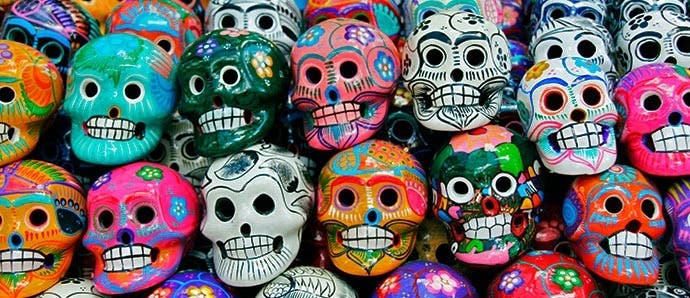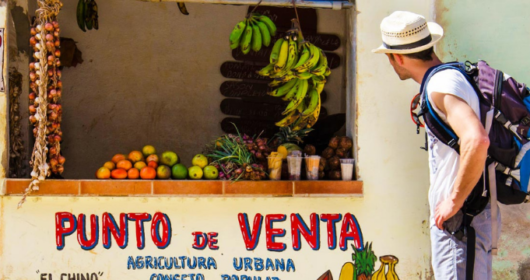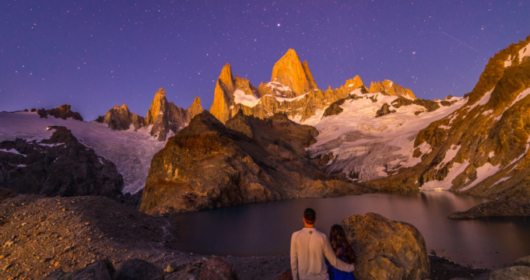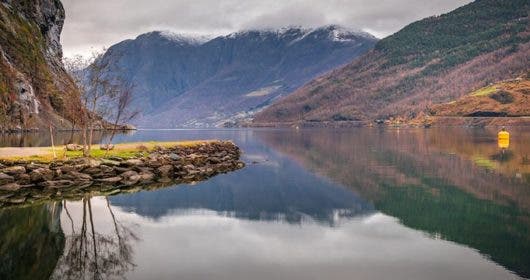Halloween around the globe

Día de los Muertos, Halloween, All Saints, Samhain… Depending on the country where you are, this celebration has different names and traditions. What they do have in common are the protagonists of the evening to whom they pay tribute between the night of October 31 and November 1 and 2: the dead.
Index
Day of the Dead
Día de los Muertos in Mexico
The Day of the Dead in Mexico has a pre-Columbian origin. The Mexican calendar kept several days to honor the deceased. The ceremony was dedicated to the goddess Mictecacíhuatl, known as the lady of death and nowadays as the Catrina. this a character created by the Mexican illustrator José Guadalupe Posada more than 100 years ago. This figure, which has become one of the country’s badges, takes on special relevance in the celebrations of November 1 and 2 when the different locations of Mexico are filled with altars that honor the family deceased, Mexicans make food and decorations offerings at such domestic altars. In Aguascalientes, the Calaveras Festival has also great relevance- The celebrations include different events, parades, exhibitions of altars and literary contests.
Gastronomy in Mexico also plays an important role in the celebrations. During those days the locals eat the so-called bread of the dead. This is a roll in the shape of characters; or candy skulls, which usually have the name of the deceased inscribe don them.
How Halloween is celebrated in the United States
Also known as the night of witches, we can find the origins of this pagan festival in the Celtic or Christian customs that the European immigrants introduced in the American continent. The festival is celebrated on October 31. During the day, children and adults dress up like horror characters. Celebrations include different private or school night parties, bonfires, and visits to cemeteries. The youngest usually go knocking on the neighbors’ doors and asking for sweets. This is the popular “trick or treat” game made so famous thanks to movies and TV series. Pumpkins, spider webs or bats are very common elements of decoration.
Although Halloween is possibly the most internationalized holiday of the deceased, the countries in which it has a strong tradition are the United States, Canada, Ireland, and the United Kingdom. As for its cuisine, during that day there is a habit of eating sweets and caramelized apples.
Samhain in Ireland
This pagan festival, of Celtic origin, was one of the most important in Europe until Christianity became the rule. Before that, the New Year started at the end of October, during the longest night of the year. The celebration was also connected with the end of the harvest and the fact that there were enough provisions until the arrival of spring. According to mythology, during that night, the deceased had the opportunity to return to the world of the living to reunite with their loved ones. Since not all spirits were good, food was left outside to scare away bad people. They also lit bonfires to prevent being kidnapped to the underworld. Masks were worn to confuse the spirits. This, that might sound a bit weird to us, is a tradition that the Irish immigrants introduced in the United States and that led to the current Halloween.
The typical sweet of this night is the Barm Brack, a case that hides a ring and a penny. The person who finds the ring while eating the cake will soon marry. If you find the penny, you will be prosperous.
All Saints Day in Spain
On November 1, Spain celebrates All Saints’ Day. This is a Christian festival in which homage is paid to all the deceased who now live in the presence of God. During the whole day, the custom is to visit the cemeteries to leave flowers and candles to the loved ones. There are also masses and some cathedrals bring out the relics of their saints. Spaniards replace pumpkins with chestnuts, nuts and some sweets such as doughnuts.
In Catalonia, on the night of October 31, they celebrate the chestnut festival, where this fruit is consumed as well as panellets, the typical sweets of the region. In some regions of Andalusia, this celebration is known as the Tosantos. If you want to experience markets, go to Cadiz. There, the markets of Virgen del Rosario or Central recreate a whole Carnival in which chickens, rabbits, fish, and pigs are disguised. People make caricatures of the most relevant celebrities with fruits and vegetables. In the Canary Islands, they have also added a touch of joy to the night, as their Fiesta de finaos is celebrated with music and performances.
In Soria, it is the day in which tribute is paid to Gustavo Adolfo Bécquer and Monte de las ánimas. The reading is interpreted at nightfall by actors and puppets that fill the city with art. In Alcalá de Henares the theatre is also very present. Every year during these dates the most famous play by José Zorrilla takes place: Don Juan Tenorio.
Day of the dead in Guatemala
Giant barrels
In Guatemala, the All Saints holiday is also deeply rooted. During these days in most of the country, altars are created in which the deceased are remembered. Many of them are homemade, and some houses have their own ones. The tradition also includes visiting the cemeteries to leave flowers, cleaning the tombstones and praying for loved ones. However, the ritual that attracts the most attention in this country is the giant barrels. This festival was born in the town of Santiago Sacatepéquez and is celebrated on November 1 and 2. It consists of throwing barrels into the air by the hill next to the cemeteries. A jury evaluates both the design of the barrels, in which groups of friends and neighbors have been working for months, as well as how long the barrel is in the air.
All Saints Day in the Philippines
Party among the dead
Although in the Philippines All Saints’ Day is also a religious festival, this country surprises with the joy with which the locals honor their deceased. The epicenter of the party is the cemetery itself. There, from the morning of December, the 1st families meet up to spend the day there with loved ones who have already parted. There they set up their banquet, composed of large amounts of food and drinks that will help raise the tone of the party throughout the day. It is common to see some karaokes or card games. Once the day is over, the Filipinos are in charge of cleaning the tombstones well and leaving them as they were, in addition to leaving some flowers as a tribute.
Day of the dead in Brazil
Día dos Finados
Brazil
Declared a national holiday, the Day of the Dead in Brazil is known as Día dos Finados. It was introduced in the country by Portuguese immigrants, so this religious celebration is very similar to the one that takes place in Spain. On November the 2nd, Brazilians go to the cemeteries to visit their deceased. Unlike in other countries of Latin America, you can only find altars in graveyards. Once in front of the tombstones of their loved ones, Brazilians pray so that the souls who are in purgatory can go out. Afterward, they clean their tombstones and decorate them with candles and wreaths. In some cases, it is also common to see personal items that belonged to the departed ones, such as t-shirts, caps or photos. You can visit Brazil in October and get to know a different side of it.
The day of the ancestors in Cambodia
Pchum Ben
Known as the day of the ancestors, this festival held in Cambodia is one of the most popular in the country. If you think that Vietnam and Cambodia are just all about temples, you are wrong. They celebrate the opening of the gates of hell. This means that those souls who have not been able to reincarnate come back to life to mingle with their loved ones. To guide them on the right path, family members must offer them food. This is how at nightfall many of the pagodas in the country are filled with believers who come to take the offerings. During the night the monks also perform chants, to redirect the lost souls towards reincarnation. Before dawn, Cambodians go to bed and the main cities are calm waiting for the spirits to go to collect food.
This festival does not coincide with those celebrated in other parts of the world. The fact is that the date depends on the Khmer calendar. It is usually celebrated in the months of September or October.
If you liked how the Day of the Dead is celebrated in different parts of the world, share it!







Comments are closed.